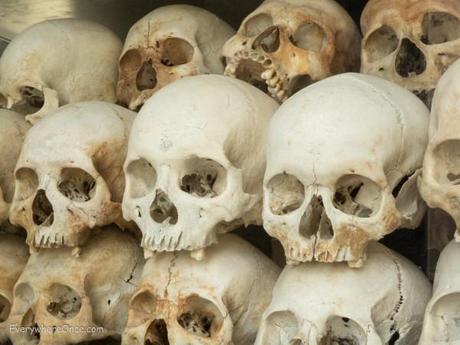
Some things in life are just too awesome to fully comprehend. And at Choeung Ek, an otherwise nondescript orchard a dusty 17 kilometer tuk-tuk drive outside of the Cambodian capital of Phnom Penh, that statement holds true in the worst possible way imaginable.
Between 1975 and 1979 the Khmer Rouge regime under Pol Pot killed roughly two million people. The truth is, nobody really knows how many men, women, and children fill the roughly 20,000 mass graves that dot Cambodia’s landscape. Estimates range from a low of about 700,000 to over three million.
Words like atrocity and genocide are powerless to adequately describe the madness that is Cambodia’s Killing Fields.
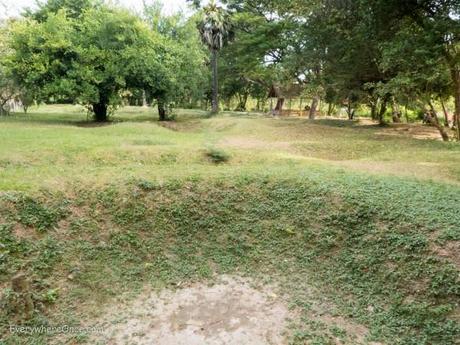
The ground ripples with excavated mass graves
Even touring a place like Choeung Ek, one of Cambodia’s most notorious execution camps, only offers the slightest glimpse of what transpired during those four unimaginable years of Khmer Rouge rule. And yet the magnitude of the horror at that single site is still impossible to behold.
People were brought to Choeung Ek by the truckload for extermination. It was mass murder on an industrial scale. But the backwards industry of the Khmer Rouge killing machine couldn’t keep pace with Pol Pot’s ambition for slaughter. At its peak the flow of the condemned into the camp became so great that its officers couldn’t execute them all.
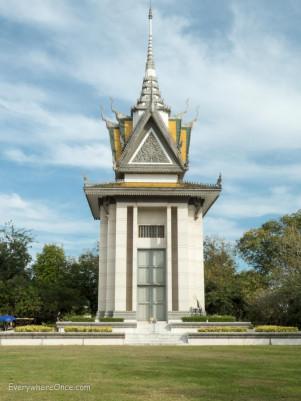
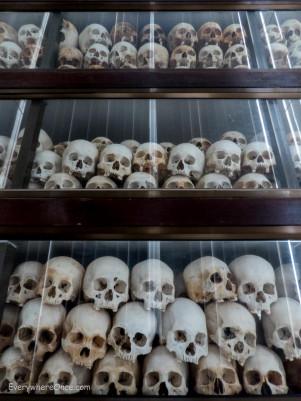
The Buddhist stupa erected as a memorial at Choeung Ek houses 5,000 skulls recovered from the site.
So they built temporary structures to warehouse people awaiting execution and hung loudspeakers from trees to hide the sounds of the dying from the ears of the soon to be dead.
In all, 8,895 bodies were recovered from mass graves at Choeung Ek. An unknown number remain interned beneath still unexcavated fields; buried, but not forgotten. Even after forty years their bodies will not let us forget. Bits of bones and clothes still rise from these unmarked graves to remind the living of their loss.
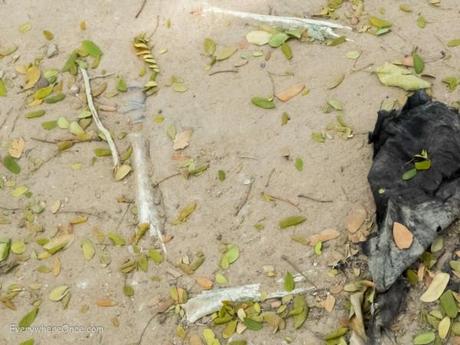
Bone fragments and clothing tatters along a path at Choeung Ek
As I stepped gingerly around the remains I tried and failed to put this horrible place into perspective. Choeung Ek is just one of 300 similar killing fields spread throughout the country. During its reign the Khmer Rouge is thought to have killed roughly a fifth of Cambodia’s population. And they did it all in less than four years.
To experience a similar magnitude of loss in my own country would require the U.S. to endure a September 11th sized attack every ninety minutes, every day of the week, for 195 straight weeks.
But even that analogy doesn’t go nearly far enough. Unlike the 9-11 murderers, Pol Pot’s killing wasn’t random. He specifically targeted intellectuals, teachers, artists, and scientists, not to mention people who wore glasses or had soft hands. He did more than just kill enemies of his regime. His policies targeted the very means by which a modern society sustains itself and preserves its culture. It’s a wonder anything survived him.
And yet away from the Killing Fields, Pol Pot’s legacy isn’t exactly obvious today. Cambodia’s cities are vibrant. Its economy has performed better than many of its neighbors. And everywhere we turned we saw its wonderful, friendly, resilient people smiling and working and laughing and playing.
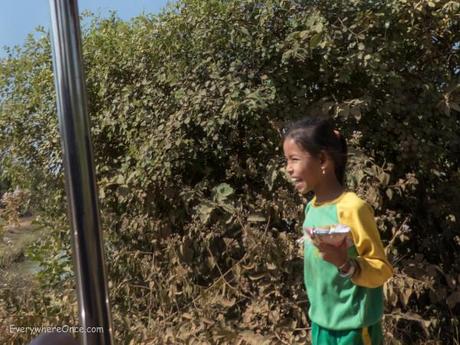
A Cambodian girl laughs hysterically with her friends after waving to us as we passed in our tuk-tuk
Fewer than two generations after an incomprehensible reign of terror, life in Cambodia goes on pretty much as it does elsewhere. Some things really are just too awesome to fully comprehend.

